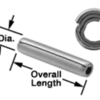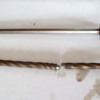After being respectfully disagreed with I initially just walked away from this thread. I was willing to let you guys believe whatever you want, but Chris' honest question brought me back. Here's a guy that innocently asks, "is this something I need to be concerned about?" And outside of the Pantera hobby the answer is an emphatic no! If you don't install that heavy duty shaft, the roll pin isn't gonna snap! That's the way Ford built it. Ford wouldn't stay in business very long if its cars were leaving owners stranded regularly.
quote:
Originally posted by JTpantera:
... What is your source of knowledge around this design feature ... However, you state with emphatic confidence that this was an intended design element by Ford engineers ... I'd really like to know whether this is reasonable conjecture based on visual observation of the twisted shaft or does this design element exist stated in a document produced by Ford or it's engeeneers responsible for the engine's design ... I'm trying to cut through fact and Panteraspeak ...
I do indeed have Ford documents that describe the purpose for the heavy duty shaft as "to eliminate spark scatter".
Can anyone with a contrary opinion provide Ford documents prescribing any other use for a heavy duty oil pump drive shaft?
I don't have Ford docs old enough to describe the design of the hex shaft, the docs I have just mention it in passing as a "heavy duty 5/16" hex shaft".
Please stand back and look the oil pump drive system over. Look how many twists that shaft took without shearing a roll pin! The pump had a serious problem, but the car kept running, it left nobody stranded. Doesn't that seem like an engineered system?
Install a heavy duty shaft and the roll pin shears very quickly. That is not an engineered system any longer, is it? So next you have to beef up the roll pin. Let me ask you this, where's the give in the system after you beef up the roll pin? What will twist or shear next when the pump tries to stall? The hexes on the shafts end? The distributor shaft where its drilled for the roll pin? The teeth on the distributor drive gear? The gear teeth ground into the camshaft? Where's the engineering now?
quote:
Originally posted by jb1490:
... Are both of those shafts from the same displacement engines ...
Hi John. Its not my picture, but no, those shafts aren't for the same vehicle. One is much shorter than the other.
quote:
Originally posted by Panterror:
... Several twists are normal? Maybe on junk yard engines. To me it's just a sign of a poorly maintained engine that has survived a couple of near oil pump failures and/or correspondingly one that has had a lot of debris through its lubrication system ...
Precisely. I did write that the shaft from a well maintained motor may not have any twists.
quote:
Originally posted by Panterror:
... Looks like every shaft that comes out of an engine with a seized oil pump to me. How do you know those twists developed over 20-30 years and not just as a result of a catastrophic failure caused by debris too large from the pump to tolerate ...
I'm trusting the evaluation of the mechanic who emailed the picture to me. He had never seen a shaft with so many twists and thought I'd enjoy seeing it too. I did. I laughed, but at the same time, it answers the question, just how many twists can these shafts take.
quote:
Originally posted by Panterror:
... If shafts really do routinely twist multiple revolutions in use, one could argue that is truly a means of making the engine more tolerant of gear rotor oil pumps intolerance to debris and it would wreck fewer engines and strand fewer people by not failing catastrophically ...
One could indeed take that position

quote:
Originally posted by Panterror:
One could also argue that the weak link should be the roll pin so an engine that may have just lost it's oil pump is shut down by losing its timing mechanism too.
Ford obviously took the former position.
quote:
Originally posted by Panterror:
... you’re a faithful disciple of the Ford engineers ...
I have no problem calling a terd a terd. Engineers are humans, they make mistakes. I bump heads with inept engineers every day. Most engineers would tell you its the managers and accountants that screw things up. But often hobbyist call good engineering "bad engineering" because they don't understand it, or they don't understand the criteria, or they don't understand the process involved in designing things for something like a large automotive corporation. Automotive engineers don't engineer haphazardly like some hobbyists believe. Things are designed, reviewed, tested, reviewed, evaluated, reviewed. Several designs for the same part are often compared before a decision is made regarding which design to put into production.
In general, I believe Ford put a lot more engineering into the original parts than the aftermarket and hobbyists put into the replacements. That was especially true in the 1960s which is when my involvement with cars began.
_______________________________________________________
I have a story for you.
I had built a stout little 302 to replace the tired 289 in a fellas Mustang. One evening I get a phone call, the guy says the motor I built "just stopped" and left him stranded. It was his work car and he needed it fixed asap. I spent the evening at his home, troubleshooting the motor. After a lot of head scratching and butt scratching I accidentally noticed the distributor rotor wasn't turning when my customer cranked the motor. I pulled the dizzy and found the sheared pin.
The next day I skipped school and took the dizzy to the race shop I hung out at (with a case of Bud) and asked one of the guys "whats up with this". He looked me in the eye and asked me straight out "why did you install a heavy duty oil pump shaft in that motor?" Uh Oh ... I hadn't mentioned the heavy duty pump shaft to anyone yet. I knew I was in for a "lesson".
Well I didn't want sparks to scatter! lol
He asks "when has spark scatter been a problem in the past"
Uh .... never
"So the heavy duty shaft was a solution to a problem you didn't know you had?"
Uh ... yeah
"Learned your lesson?"
Yeah ....
the good ol' days
I'd give my eye teeth if I could walk back in that shop today with a case of beer
put up with their teasing, see their old weary faces, hear their gruff voices
-G




